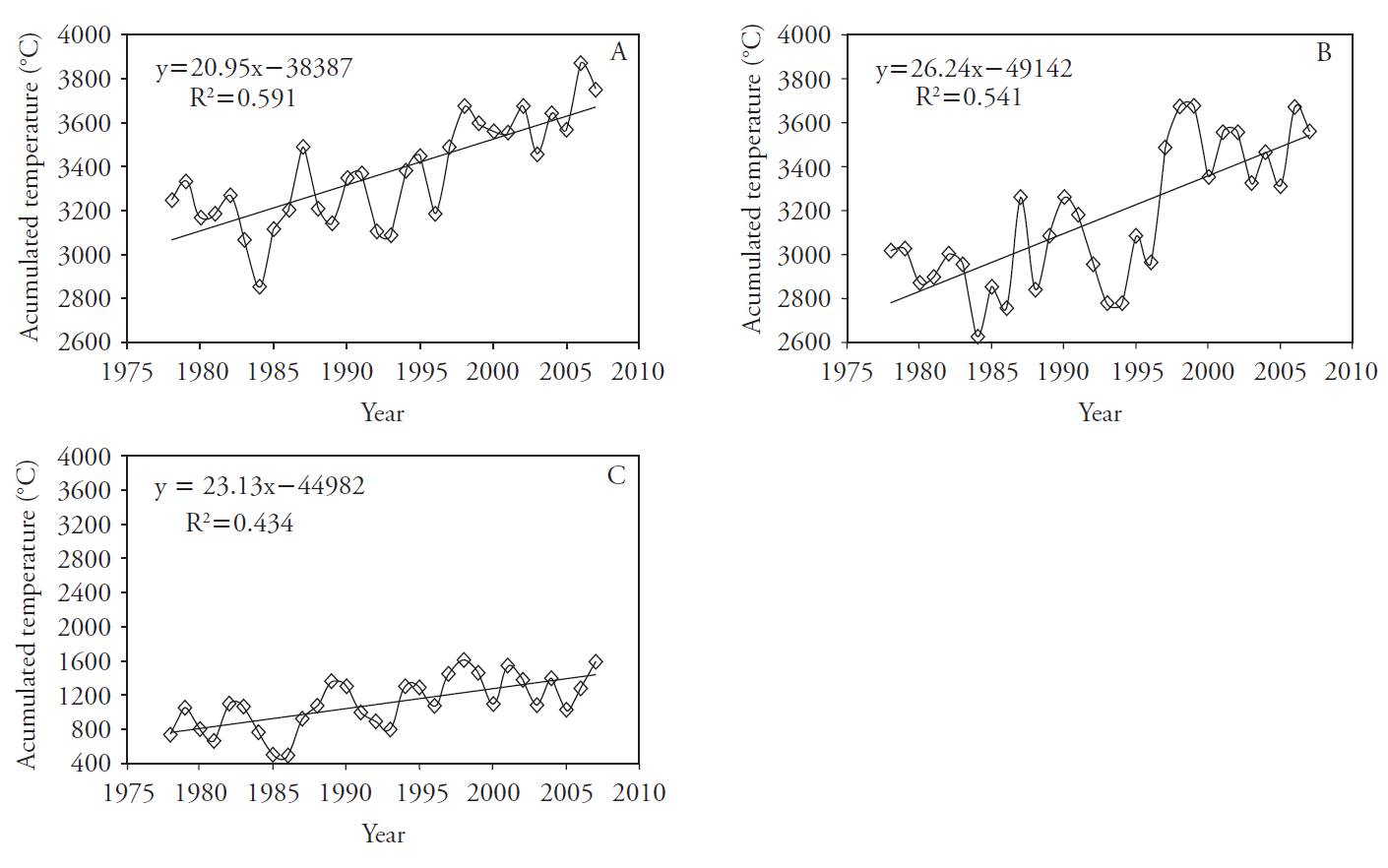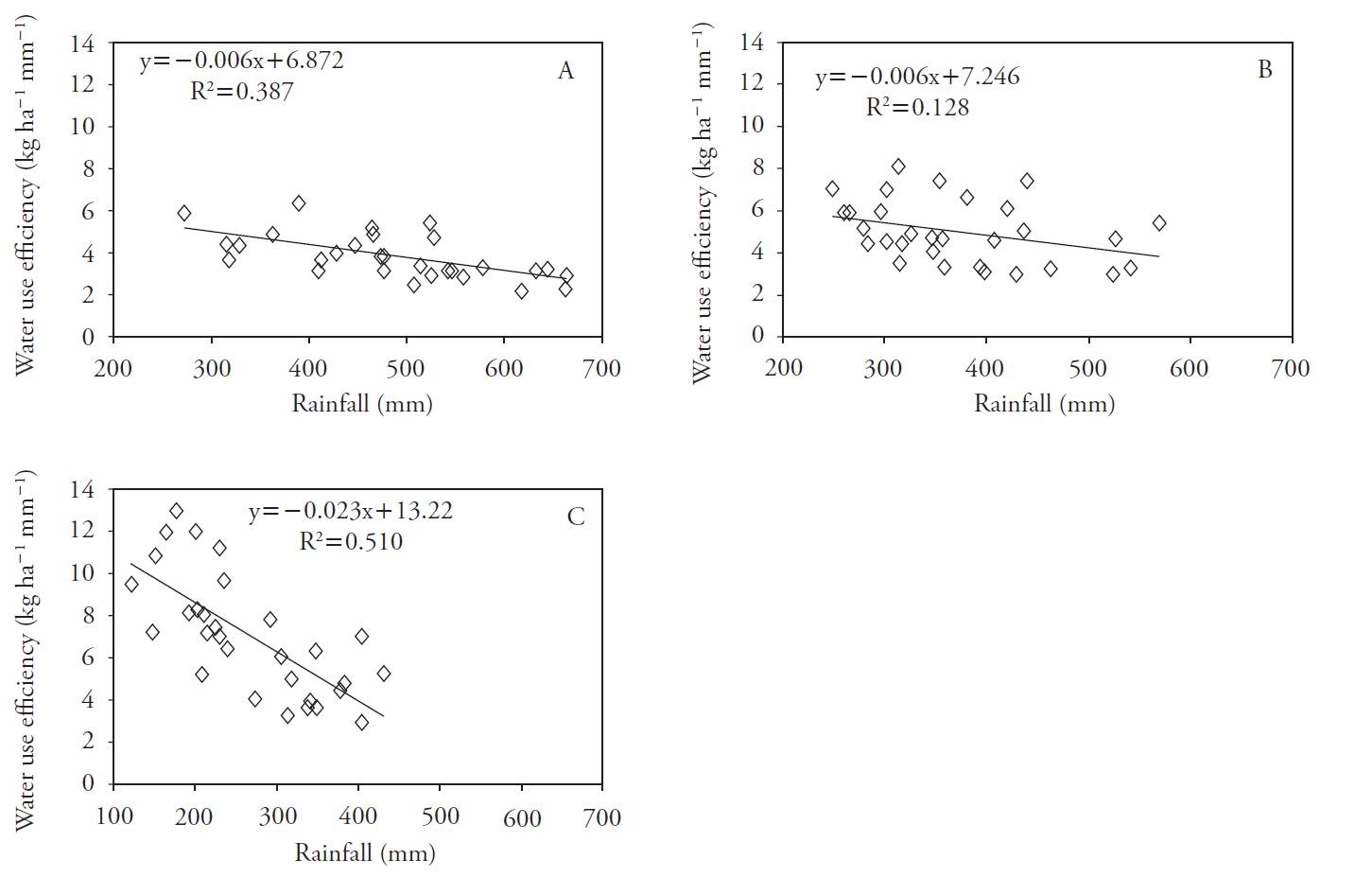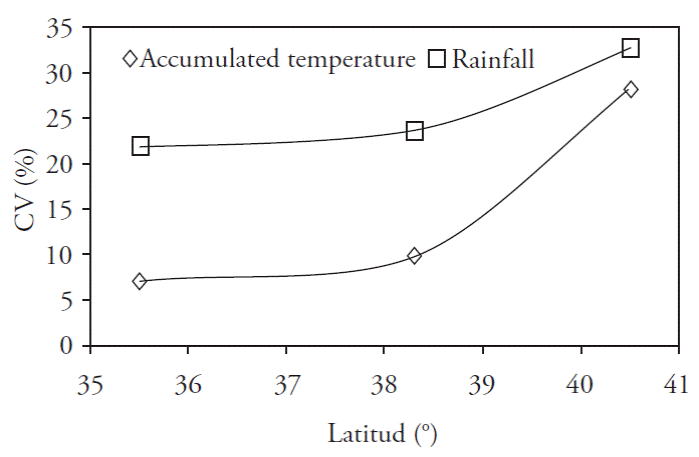Introduction
Water use efficiency (WUE) is an important factor of agricultural production in arid and semi-arid areas of China. Climate warming as an upward trend all over the world may pose an important challenge to WUE (Sommer et al., 2013). Climate change affect crop growth and yield, especially accumulated temperature (sum of daily mean temperature) and daily mean temperature (Galán et al., 2001). Temperature increase causes variation in growing period of crops, and may sometimes cause a change in the cropping system (Avolio et al., 2008). Several crops, therefore, will become more suitable for cultivation further north or in higher altitude areas in the south (Olesen et al., 2007; Moriondo et al., 2010).
The phenology of crops, such as jointing, flowering, and maturity, may be affected by climate warming and may have an overall trend of earlier occurrence (Osborne et al., 2000; Giannakopoulos et al., 2009; Oteros et al., 2013). The earlier occurrence of phenological phases due to the influence of climate warming resulted in a shorter time for biomass accumulation and lower crop yields (Olesen et al., 2011). Rosenzweig et al. (1993) assessed the effects of climate change on global food production, and then Parry et al. (2004) estimated yield of main crops to drop by between 2.5 % and 10 % as compared with historic from 1990 conditions due to climate warming.
As far as WUE was concerned, crops transpiration and soil moisture loss were severe in arid and semi-arid areas due to climate warming (Tenhunen et al., 2002). According to Lioubimtseva and Henebry (2009), WUE of crops was affected by low precipitation because of climate warming. Likewise, climate warming could drop effective evapo-transpiration of rain-fed olives due to reduction of precipitation and increase of evapo-transpiration demand (Lazar et al., 2014). Further, climate warming could improve WUE of wheat, potato, and maize (Xiao et al., 2013).
Foxtail millet (Panicum italicum L.), one important food source in rain-fed areas of China, is one of the oldest domesticated crops (Shen et al., 2015). The effect of climate change on WUE of foxtail millet has not been recently assessed. Therefore, the objective of this study was to understand the impact of climate change on WUE of foxtail millet in rain-fed areas and to suggest agricultural strategies for adapting to climate change, in China.
Materials and methods
Study area and data sources
Pingliang, Yulin, and Hubehot were selected as study meteorological stations in semi-arid and arid regions, which are located in 34° 54’ N and 108°30’ E, 37° 5’ N and 107° 36’ E, and 40° 51’ N and 110° 46’ E, respectively. Soil type in these locations is loessal with 30 m depth layer.
Rainfall, temperature, yield of foxtail millet, and soil moisture data for the semi-arid and arid areas of Yulin, Pingliang, and Hubehot between 1978 and 2007 were acquired from the Meteorological and Agricultural Administration Centers in every location.
Data analysis
The soil water content data in 0-100 cm soil profile during the sowing and harvesting stages for foxtail millet, between 1978 and 2007, were used to calculate crop evapotranspiration (ETc ). Evapotranspiration was determined using the formula (Zhang et al., 2013b):
where, P is the precipitation (mm) during the crop growth season; SW s is soil water storage (mm) at sowing stage; SW h is soil water storage (mm) at harvesting stage; I is the amount of irrigation (mm), which was negligible due to no irrigation in this study site; D is the amount of water lost due to deep drainage (mm), which was negligible due to 30 m deep water layer and less rainfall (Wang et al., 2004).
SW in evapotranspiration formula was calculated using the formula as below:
where SW is soil water storage (mm); i is soil layer number; n is total number of soil layers, including five layers of 0-20, 20-40, 40-60, 60-80, and 80-100 cm; Ai is soil dry bulk density in i layer (kg cm-3); T i is soil thickness in i layer (cm); B i is soil water content (%).
WUE of foxtail millet was calculated as grain yield (GY) in kg ha-1 divided by ET c :
Results and discussion
Climate evaluation
The accumulated temperature from 1978 to 2007 shows a significant upward trend (Figure 1). Accumulated temperature of Pingliang, Yulin, and Huhehot increased by 502, 541, and 857 °C, respectively, and annual mean accumulated temperature increased by 16.7, 18.0, and 28.6 °C. Temperature rise is a sign of climate warming (Wei and Chen, 2009). Accumulated temperatures of these locations, therefore, have a significant climate warming trend during the period under study.

Figure 1 Accumulated temperature change from 1978 to 2007: (A) Pingliang, (B) Yulin, (C) Huhehot, China.
Climate warming has an important effect on rainfall (Piao et al., 2010). Findings by García Páez and Cruz-Medina (2009) suggest that water shortages in regions of Mexico may become worse by variability in rainfalls due to climate change. Rainfall on Pingliang, Yulin, and Huhehot showed a variation trend as the accumulated temperature rose (Figure 2), and rainfall on these locations decreased by 75.0, 84.3, and 162.5 mm. Annual mean rainfall of these locations dropped by 2.50, 2.81, and 5.42 mm in Pingliang, Yulin, and Huhehot. High accumulated temperature increase may result in serious rainfall losses, which might be harmful to agricultural production in semi-arid and arid regions (Wang, 2009).
WUE of foxtail millet and temperature
Temperature, as an important factor for agricultural production, has a necessary effect on WUE. Temperature rise has caused increase of plant WUE (Loader et al., 1995). However, other reports also suggest that temperature rise decreased WUE of plant (Yepez et al., 2007; Nicotra et al., 2008). The relationship between WUE of foxtail millet and temperature change is presented in Figure 3. WUE of foxtail millet in Pingling, Yulin, and Huhehot increased when accumulated temperature of these locations increased by 100 °C between 1978 and 2007, and they increased by 0.2, 0.2, and 0.4 kg ha-1 mm-1 (Figure 3). These results were similar to those reported by Xiao et al (2013), who found WUE of wheat increased when temperature increased. As far as reasons of increasing WUE under temperature warming was concerned, Schleser (1990) and Loader et al (1995) reported that WUE increased when temperature rose under the optimal temperature for photosynthesis, or else it decreased above optimal temperature for photosynthesis (Yepez et al., 2007; Nicotra et al., 2008). In our study, WUE of foxtail millet increased as accumulated temperature rose; suggesting that temperature rise between 1978 and 2007 was under the optimal temperature of photosynthesis in foxtail millet, which may cause photosynthetic capacity of foxtail millet to increase and lastly resulting in high WUE. These results are supported by the finding of Duquesnay et al (1998), who indicated that effects of temperature rise on WUE of beech were positive in the long term. Increasing WUE under warming temperature, suggests that water vapor capacity increased (Philip and Biney, 2002); therefore, WUE of the plant increased as a response to adjust for drought (Figure 3) (Zou et al., 2010). WUE of foxtail millet increased about 0.3 kg ha-1 mm-1 when accumulated temperature increased by 100 °C between 1978 and 2007. This indicates that an increase in WUE of foxtail millet may be the manifestation of an adaptation to arid and semi-arid environments, which is supported by the finding of Zou et al (2010) in Haloxylon ammodendron.
Water use efficiency of foxtail millet and rainfall change
Farquhar et al. (1982) suggest that many factors, such as precipitation rise, stomatal conductance and high transpiration rates, result in low WUE of plants in humid and semi-humid areas. These factors, particularly rainfall, played an important role in WUE of plant (Xie et al., 2016). In our study, WUE of foxtail millet decreased when rainfall increased (Figure 4). In other words, rainfall decreased 100 mm between 1978 and 2007, whereas WUE of foxtail millet increased about 1.2 kg ha-1 mm-1 (Figure 4). Increasing rainfall may improve crops yield (He et al., 2013). However, rainfall rise limited increment of 13C content in plant leaves, which caused WUE of plants to decrease (Farquhar et al., 1982; Diefendorf et al., 2010). Therefore, increasing rainfall may result in WUE of foxtail millet to decrease. Oppositely, temperature warming led to decreasing rainfall between 1978 and 2007, and drought frequency and duration were enhanced. These factors played a positive effect on increasing WUE of foxtal millet. These results agree with the finding of Ogaya and Penuelas (2003), who found that crops in arid and semi-arid environments, had a higher WUE compared with that of humid environments.

Figure 4 Impact of rainfall on water use efficiency of foxtail millet: (A) Pingliang, (B) Yulin, (C) Huhehot, China.
A study by Chen et al. (2003) show that WUE of desert plants had a significantly negative correlation with annual precipitation. Ogaya and Penuelas (2003) report a high WUE of plants under drought conditions. In our study, WUE of foxtail millet was higher as rainfall decreased, suggesting that WUE it improved in drought environments. In the long term, drought caused plants to change to adapt to drought, such as low stomatal conductance and transpiration rate, and high 13C content in plant leaves. Variation of these factors directly resulted in high WUE (Yang et al. 2007; Prentice et al. 2011). Foxtail millet was planted since long ago and may have increased its WUE to adapt to arid environments in the Northwest of China.
Temperature variation and rain-fed farming
Global warming is a fact all over the world (Agnes et al., 2016). Temperature has changed and influenced crop production significantly (He et al., 2015). Agriculture is one of the most climate dependent economic sectors (Hansen, 2002), especially in rainfed regions. In our study, Huhehot, a high latitude region (N 40° 51’), had high CV of accumulated temperature and rainfall (Figure 5). This indicated that temperature warming and decreasing rainfall were severely altered in arid and semi-arid regions of high latitudes in China, coinciding with findings from Ding (2007).

Figure 5 Relationship between coefficient of variation (CV) and latitudes of study areas (Pingliang, Yulin, and Huhehot, China).
Average WUE of foxtail millet between 1978 and 2007 increased when CV of accumulated temperature and rainfall moved up (Figure 6). These results suggest that temperature warming and decreasing rainfall were important factors in enhancing WUE of foxtail millet. Although temperature rise may increase WUE of crops, this is a negative adaptation under water-stress conditions. There are suggested negative impacts on crop yield due to climate warming in arid and semi-arid areas (Knox et al., 2012; Muller, 2013; Nkulumo et al., 2014). If temperature rise and precipitation decrease to a point that cannot meet crops need, food security is at risk in arid and semiarid regions (Zhang et al., 2013a).

Figure 6 Impact of coefficient of variation on average water use efficiency of foxtail millet; A: accumulated temperature, B: rainfall.
How limited rainfall can be used more efficiency? How to save rainfall? What to plant? How to plant? These are important questions that need to be answered to adapt to the agricultural challenge posed by recent temperature warming in arid and semiarid areas of China. Adjusting plantation structure among different crops and increasing plant areas of crops with high WUE to protect from drought, such as foxtail millet, proso millet, and sorghum, are necessary for increasing food security. Moreover, farming techniques that have a high effect on conserving rainfall and increasing yield of crops in arid and semi-arid areas, such as conservation tillage (Amir et al., 2012), plastic-film mulching (Wang et al., 2004), rainfall harvesting system based on special soil tillage (Qu et al., 2012), and limited and supplement irrigation (Christian et al., 2010), should be adopted by farmers and spread for food production in arid and semi-arid areas of China.
Conclusions
Temperature warming and decreasing precipitation have caused severe droughts in arid and semi-arid regions in China. However, these conditions have resulted in high WUE of foxtail millet to adapt arid environment between 1978 and 2007. To mitigate the influences of global warming on crop production in arid and semi-arid regions strategies such as improving crop distribution, increasing plant areas of foxtail millet with high WUE, and the adoption of drought-resistant farming techniques should be used in the northwest regions of China.











 texto em
texto em 




